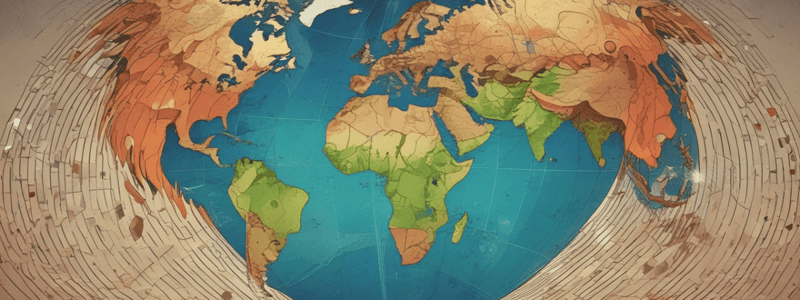Podcast
Questions and Answers
What is the point within the Earth where an earthquake originates?
What is the point within the Earth where an earthquake originates?
- Fault line
- Hypocenter (correct)
- Seismograph
- Epicenter
What is the purpose of the epicenter in seismology?
What is the purpose of the epicenter in seismology?
- To determine the depth of an earthquake
- To map and identify the geographic area affected by the earthquake (correct)
- To record seismic waves
- To calculate the distance from the seismograph
What is the main difference between the focus and the epicenter?
What is the main difference between the focus and the epicenter?
- One is on the surface and the other is subsurface (correct)
- One is used to calculate the distance from the seismograph and the other is used to determine the source of the seismic activity
- One is used to measure the depth of an earthquake and the other is used to measure the distance
- One is used to map the affected area and the other is used to record seismic waves
What is the method used to determine the location of a point by forming triangles to it from known points?
What is the method used to determine the location of a point by forming triangles to it from known points?
What is the purpose of measuring time differences in triangulation?
What is the purpose of measuring time differences in triangulation?
What type of waves travel faster and arrive first at a seismograph?
What type of waves travel faster and arrive first at a seismograph?
What is the term for the location on the ground where the effects of the earthquake are typically the strongest?
What is the term for the location on the ground where the effects of the earthquake are typically the strongest?
What is the purpose of recording seismic waves at different locations?
What is the purpose of recording seismic waves at different locations?
What happens to the effective stress between soil particles as water pressure rises?
What happens to the effective stress between soil particles as water pressure rises?
What is the method used to determine the epicenter of an earthquake?
What is the method used to determine the epicenter of an earthquake?
What is the main consequence of ground instability during earthquakes?
What is the main consequence of ground instability during earthquakes?
What type of seismic wave can only move through solids?
What type of seismic wave can only move through solids?
What does the Richter scale measure?
What does the Richter scale measure?
What is the main difference between magnitude and intensity?
What is the main difference between magnitude and intensity?
What is the primary difference in the formation of intrusive and extrusive igneous rocks?
What is the primary difference in the formation of intrusive and extrusive igneous rocks?
What is the main difference between P waves and S waves?
What is the main difference between P waves and S waves?
What is the most common cause of tsunami formation?
What is the most common cause of tsunami formation?
What is the process by which metamorphic rocks are formed?
What is the process by which metamorphic rocks are formed?
What is the characteristic texture of extrusive igneous rocks?
What is the characteristic texture of extrusive igneous rocks?
What is the primary way that sedimentary rocks are formed?
What is the primary way that sedimentary rocks are formed?
What is a characteristic of sedimentary rocks?
What is a characteristic of sedimentary rocks?
What happens to S waves when they encounter the Earth's outer core?
What happens to S waves when they encounter the Earth's outer core?
What is the term for the phenomenon where saturated soil temporarily loses its strength and stiffness in response to an applied stress?
What is the term for the phenomenon where saturated soil temporarily loses its strength and stiffness in response to an applied stress?
What is the main cause of landslides during earthquakes?
What is the main cause of landslides during earthquakes?
What is the fundamental principle used for relative age dating of sedimentary rock layers?
What is the fundamental principle used for relative age dating of sedimentary rock layers?
What type of seismic wave causes the most damage during an earthquake?
What type of seismic wave causes the most damage during an earthquake?
What is the purpose of identifying and correlating sedimentary rock layers across different regions?
What is the purpose of identifying and correlating sedimentary rock layers across different regions?
What is the Moment Magnitude Scale (Mw) used to measure?
What is the Moment Magnitude Scale (Mw) used to measure?
What is the significance of index fossils in relative age dating?
What is the significance of index fossils in relative age dating?
What is the result of liquefaction during earthquakes?
What is the result of liquefaction during earthquakes?
What is the primary difference between P waves and long waves?
What is the primary difference between P waves and long waves?
What is the Modified Mercalli Intensity (MMI) scale used to measure?
What is the Modified Mercalli Intensity (MMI) scale used to measure?
What is the significance of geological features like faults and intrusions in relative age dating?
What is the significance of geological features like faults and intrusions in relative age dating?
What is the purpose of drawing circles on a map around each seismograph station?
What is the purpose of drawing circles on a map around each seismograph station?
What is the primary difference between metamorphic and sedimentary rocks?
What is the primary difference between metamorphic and sedimentary rocks?
What is the term for the area on the Earth's surface where S waves are not detected directly?
What is the term for the area on the Earth's surface where S waves are not detected directly?
What is the significance of reconstructing the geological history of an area?
What is the significance of reconstructing the geological history of an area?
What is the primary way that igneous rocks are classified?
What is the primary way that igneous rocks are classified?
What is the primary purpose of relative age dating?
What is the primary purpose of relative age dating?
What is the result of radioactive decay?
What is the result of radioactive decay?
What type of radioactive decay involves the emission of an alpha particle?
What type of radioactive decay involves the emission of an alpha particle?
What is the half-life of a radioactive isotope?
What is the half-life of a radioactive isotope?
What is the purpose of the half-life in radiometric dating?
What is the purpose of the half-life in radiometric dating?
What is a decay chain?
What is a decay chain?
Which radioactive isotope has a half-life of about 5,730 years?
Which radioactive isotope has a half-life of about 5,730 years?
What is the result of electron capture?
What is the result of electron capture?
Flashcards are hidden until you start studying
Study Notes
Seismology
- Focus: The point within the Earth where an earthquake originates, also known as the hypocenter.
- Epicenter: The point on the Earth's surface directly above the focus, where the effects of the earthquake are typically strongest.
- Comparison: Both terms refer to locations related to the origin of an earthquake, but the focus is a subsurface point and the epicenter is a surface point.
Triangulation in Seismology
- Method: Triangulation is used to determine the location of a point by forming triangles to it from known points.
- Process:
- Record seismic waves using seismographs at different locations.
- Measure the time difference between the arrivals of P and S waves at each seismograph.
- Calculate the distance from the seismograph to the epicenter using the time difference.
- Draw circles on a map around each seismograph station with radii equal to the calculated distances.
- The point where the circles intersect is the earthquake's epicenter.
Types of Seismic Waves
- P Waves (Primary Waves):
- Travel fastest and are the first to be detected by seismographs.
- Move through solids, liquids, and gases.
- Cause particles to compress and expand in the direction of wave propagation (longitudinal motion).
- S Waves (Secondary Waves):
- Slower than P waves and arrive after them.
- Can only move through solids.
- Cause particles to move perpendicular to the direction of wave propagation (transverse motion).
- Long Waves (Surface Waves):
- Travel along the Earth's surface and are slower than both P and S waves.
- Cause the most damage during an earthquake due to their high amplitude and complex motion.
- Can be further divided into Love waves (horizontal transverse motion) and Rayleigh waves (rolling motion).
Tsunami Formation
- Causes:
- Underwater earthquakes
- Volcanic eruptions
- Landslides
- Meteorite impacts
- Process: Displaced water forms waves that travel across the ocean at high speeds, increasing in height and causing destruction upon reaching shallow coastal areas.
S Wave Path
- Generation: S waves originate at the earthquake focus and travel outward.
- Propagation: S waves move through the Earth's crust and mantle in a transverse motion.
- Interaction: S waves can only move through solid materials, not liquids or gases, and are reflected or converted into other types of waves when they encounter the Earth's outer core.
- Refraction and Reflection: S waves can be refracted or reflected depending on the density and composition of the materials they encounter, creating a shadow zone.
Liquefaction
- Definition: Liquefaction is a phenomenon where saturated soil temporarily loses its strength and stiffness in response to an applied stress, such as the shaking from an earthquake.
- Process:
- Saturated soil
- Seismic shaking increases water pressure within the soil
- Loss of strength and cohesion between soil particles
- Soil behaves like a liquid
- Implications: Ground instability, surface deformation, landslides, and lifeline disruptions.
Magnitude and Intensity
- Magnitude: Measures the energy released during an earthquake, quantifying its size and strength.
- Measurement: Richter Scale and Moment Magnitude Scale (Mw)
- Intensity: Measures the effects of an earthquake at different locations on the Earth's surface, describing the severity of shaking and damage experienced.
- Scales: Modified Mercalli Intensity (MMI) scale
Rock Formation
- Metamorphic Rocks:
- Formation: Transformation of pre-existing rocks due to high pressure, high temperature, and/or chemically active fluids.
- Characteristics: Foliated or banded texture, or non-foliated if formed under conditions of minimal deformation.
- Sedimentary Rocks:
- Formation: Accumulation and lithification of sediments.
- Characteristics: Layered appearance, may contain fossils, can be clastic, chemical, or organic.
- Igneous Rocks:
- Formation: Cooling and solidification of molten rock material.
- Characteristics: Classified based on texture and mineral composition, can be intrusive or extrusive.
- Comparison: Origin, formation environment, textures, and contrast between processes.
Law of Superposition
- Definition: In an undisturbed sequence of sedimentary rocks, the oldest layers are at the bottom, and the layers become progressively younger toward the top.
- Application: Relative age dating of rocks, stratigraphic analysis, identifying sequence of events, fossil correlation, and geological features.
Radioactive Decay
- Definition: The process by which an unstable atomic nucleus loses energy by emitting radiation.
- Types:
- Alpha decay
- Beta decay
- Gamma decay
- Electron capture
- Half-life: The time it takes for half of the atoms in a sample to decay.
- Decay chains: Series of decays until a stable, non-radioactive isotope is formed.
Studying That Suits You
Use AI to generate personalized quizzes and flashcards to suit your learning preferences.




